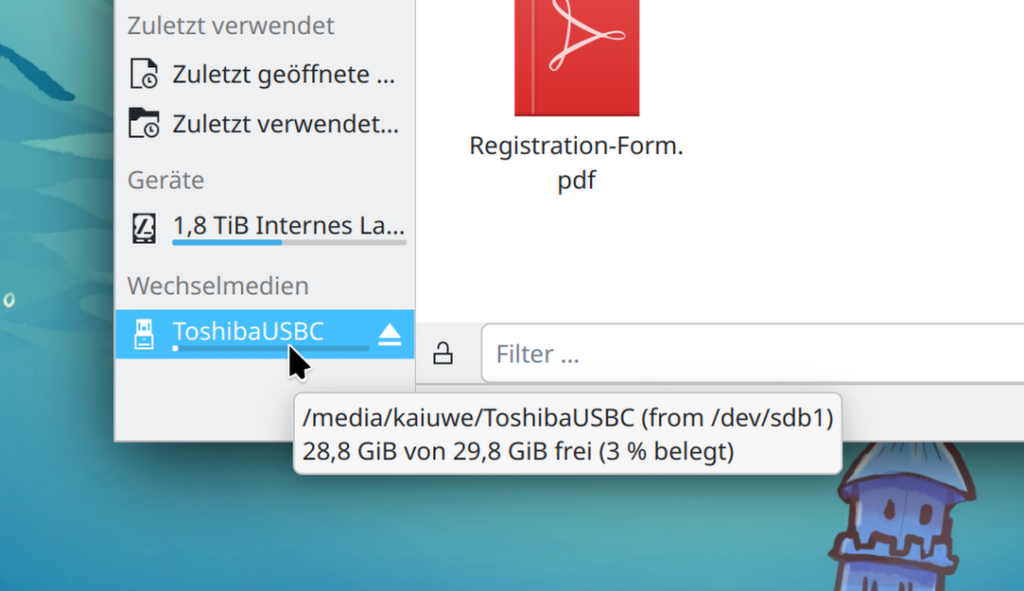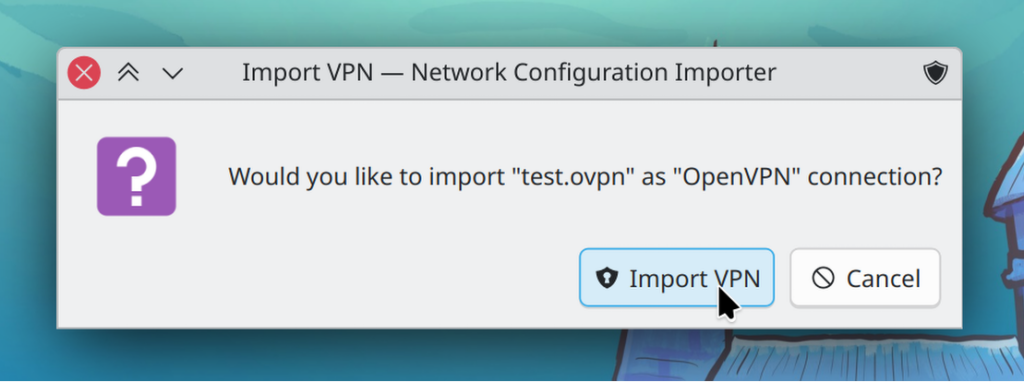Can you believe it’s already been almost half a year since Plasma 6.0 came out? Time really flies! The other day I went through some of my 50+ open merge requests on KDE’s GitLab and took another stab at them. Some are four years old at this point but it definitely helped to let them sit for a while and finish them with a fresh new perspective and clear mind.

Places panel tooltip
What really grinds my gears is elided labels with no tooltip or other means to see the full text. The Places panel in Dolphin and the file dialogs is one prime example of this. While the default locations have concise names, particularly removable media can have rather long descriptions. Additionally, while you can roughly tell how full the device is by looking at the thin line underneath, there’s no way to know precisely. You either have to browse the device or access the properties dialog through the context menu. I also added the bookmark’s destination and mount points. In case of loop devices, such as ISO images, the path to its backing file is shown instead.

The main reason I haven’t merged this feature sooner is that under Wayland the tooltips didn’t follow the item as you moved the mouse. You see, Qt reuses that window and just updates its position and text for different controls. Under Wayland, however, windows cannot just position themselves on absolute coordinates. Popup windows, such as menus and tooltips, instead provide a semantic description of where they would like to be placed using an XDG Positioner (part of the XDG Shell protocol that contains many interfaces for desktop-like use cases).
It tells the compositor, among other things, where to anchor to (e.g. a button or menu item) and what to do if it ends up outside the visible area: slide the window to fit or flip it to the other side, and so on. While Qt already used XDG Positioner for the longest time, before Qt 6.8 it did not support the reposition request. Hence the tooltip was placed correctly the first time but subsequently never moved. Since I didn’t want the patch to bitrot any further, I merged it with a check for Qt Wayland >= 6.8, so please don’t be alarmed if you cannot enjoy the feature just set. I figured, we haven’t had tooltips in there for the longest time, hence not having them for another few months is better than a distracting user experience with an influx of bug reports.
Audible feedback when (un)plugging displays
Plasma 6.0 introducted support for the XDG sound theme spec which lets applications play sound effects using a semantic name. Among those are device-added and device-removed events which are played when plugging in and out a USB device. However, there’s more things you can plug into a computer. One logical candidate is output devices: is the cable even plugged in, the projector turned on, or did it just not configure the resolution correctly?

Originally, I planned to implement it as part of the devicenotifications daemon which monitors USB devices. However, once faced with the prospect of having to monitor multiple GPUs using libdrm (note that QScreen is only enabled outputs), I realized: who knows your output devices best? The compositor, of course! Therefore, I started adding output notifications to KWin. The key difference to its normal output management is that I want to be notified of an output device whenever it is present, regardless of whether it is enabled or configured. However, it turns out there’s a KDE-proprietary Wayland protocol for managing output devices for use by our display settings module. As a result I didn’t have to change KWin and could merge this functionality with the devicenotifications daemon after all!
Import VPN configuration on click
A feature both Nico and I worked on independently from each other was the ability to import a new VPN configuration by just clicking on the file. While mine was implemented as a small helper application in Plasma Network Management, Nico put the functionality into the settings module itself by launching it with a special command-line argument. The latter approach has the advantage that it doesn’t duplicate any code dealing with VPN import (it’s all plugin-based and more complicated than you think). Therefore I abandoned my merge request and will let Nico finish his instead.

Currently it only supports OpenVPN and Cisco VPN configuration files as those are the only ones to actually have a registered MIME type in shared-mime-info and can therefore participate in file type associations. If you use any other VPN provider that Plasma supports, please get in touch so we can figure out a way to support them, too.
In just three weeks a bunch of KDE developers, designers, users, stakeholders, and many others, including myself, will meet up in Würzburg, Germany, for this year’s Akademy. Come join us, it’s always great fun and attendance is free!

Since you mentioned the XDG positioner protocol, do you happen to know anything about whether the XDG positioner protocol can be used to fix https://github.com/musescore/MuseScore/issues/15285, an huge usability issue for MuseScore on Wayland? Can you give me any pointers to what Qt already does to support this automatically, and what we can suggest as a manual fix?
If you can support importing wireguard vpn configuration
https://www.cyberciti.biz/faq/how-to-import-wireguard-profile-using-nmcli-on-linux/